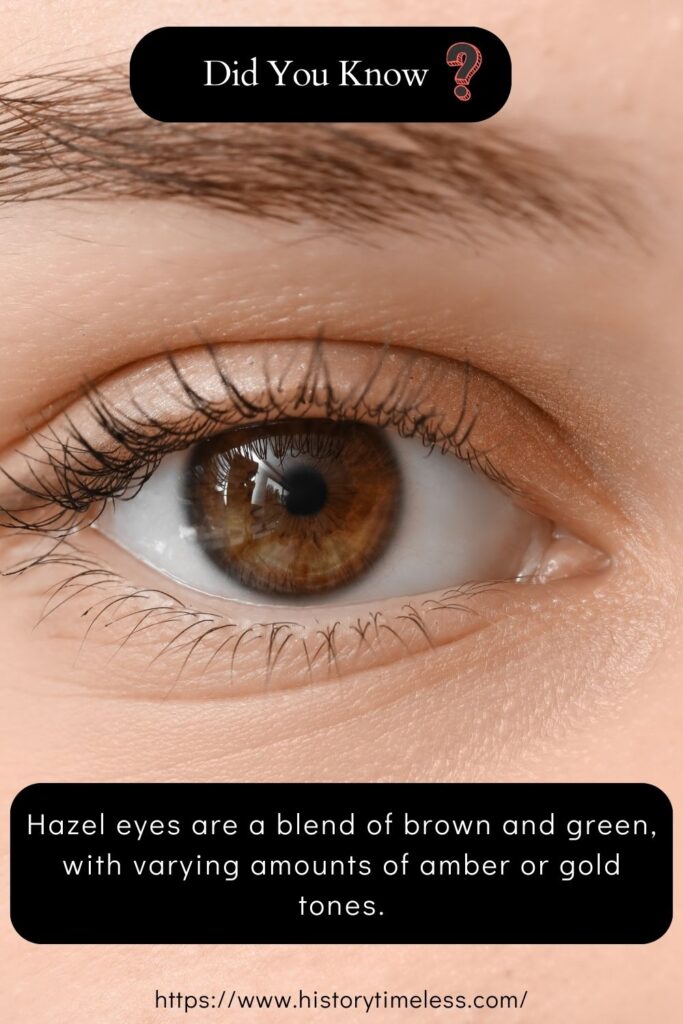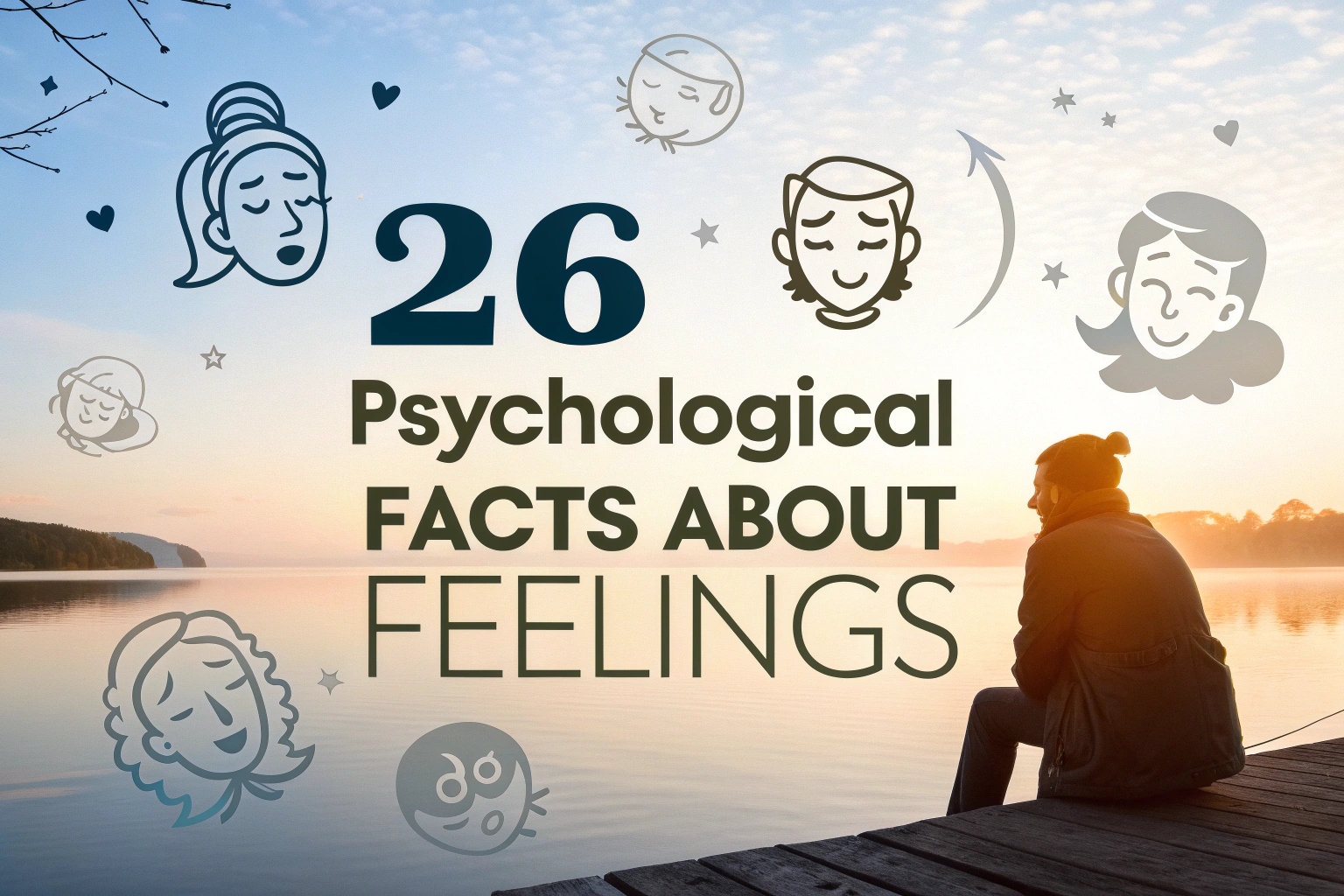Hazel eyes are a captivating and unique eye color that often seem to change depending on the lighting and surroundings. This dynamic eye color combines shades of brown, green, and amber, creating a mesmerizing effect that has intrigued many for centuries.
Hazel eyes are not only beautiful but also come with some interesting scientific facts that make them stand out among other eye colors. Here are 12 fascinating facts about hazel eyes that will leave you amazed!
1. Hazel Eyes Are a Combination of Two Colors
Hazel eyes are a blend of brown and green, with varying amounts of amber or gold tones. Unlike pure green or brown eyes, the color of hazel eyes can shift depending on the light or the clothing a person wears.

This unique combination of pigments results in eyes that appear to change color, sometimes looking more green or brown, depending on the circumstances.
2. Hazel Eyes Are Rare
Hazel eyes are considered one of the rarest eye colors in the world. Less than 5% of the global population has hazel eyes.
The rarity of hazel eyes is due to the combination of different pigments (melanin, pheomelanin, and lipochrome) that create the stunning mix of brown, green, and amber hues.
3. The Color of Hazel Eyes Can Change Over Time
Unlike some other eye colors, hazel eyes have the ability to change or shift in color over time. As a person ages or depending on external factors like lighting, their hazel eyes might appear more green, brown, or even gray.
Additionally, the intensity of the golden or amber tones can fluctuate, creating different hues depending on the environment.
4. Hazel Eyes Are More Sensitive to Light
People with hazel eyes may experience increased sensitivity to light compared to those with darker eye colors. This is because hazel eyes have less melanin, the pigment responsible for protecting against UV rays and bright light.
As a result, individuals with hazel eyes may be more prone to light sensitivity and need to take extra care when spending time in direct sunlight.
5. Hazel Eyes Have an Advantage in Low-Light Conditions
While hazel eyes may be more sensitive to light, they also have an advantage in low-light conditions. Due to the balance of brown and green pigments, hazel eyes can adapt quickly to changing light, allowing for better vision in dim environments.
This is a unique feature that distinguishes hazel-eyed individuals from those with darker or lighter eye colors.
6. Hazel Eyes Are Linked to Certain Genetic Traits
The genetics behind hazel eyes are fascinating. Hazel eyes are typically inherited as a result of a complex combination of genes passed down from both parents.
This means that even if both parents don’t have hazel eyes, they may still have the potential to pass on the genes responsible for this eye color, depending on their genetic makeup.
7. The First Recorded Use of the Term “Hazel Eyes” Was in the 16th Century
The term “hazel eyes” has been used for centuries to describe this unique eye color. The first recorded use of the term dates back to the 16th century.
At that time, people were fascinated by the ability of hazel eyes to appear to change color depending on light and mood, and the term became widely accepted to describe this captivating characteristic.
8. Hazel Eyes Are Often Associated With Warmth and Mystery
People with hazel eyes are often perceived as having a warm and inviting personality. The unique combination of golden and green hues can evoke a sense of mystery.
Which is why hazel-eyed individuals are often considered to have an intriguing or captivating gaze. This is why many cultures associate hazel eyes with traits like intelligence, charm, and allure.
9. Hazel Eyes Are More Likely to Appear in People of Mixed Ancestry
Hazel eyes are more common in people of mixed European or Middle Eastern ancestry. This is because the gene responsible for hazel eyes is a result of the mixing of various genetic traits from different ethnic backgrounds.
People from these regions are more likely to inherit the genes that produce the combination of brown, green, and amber pigments.
10. Hazel Eyes Are Linked to Certain Health Benefits
There is some evidence to suggest that hazel-eyed individuals may have certain health advantages. One study found that people with hazel eyes may have a higher level of resistance to certain types of diseases, including some forms of cancer.
Additionally, hazel-eyed individuals are often less prone to eye conditions like macular degeneration, although more research is needed in this area.
11. Hazel Eyes Can Appear Brighter With the Right Clothing
What you wear can actually influence the way your hazel eyes appear! Wearing certain colors, especially greens, browns, or earthy tones, can make the green and gold pigments in hazel eyes pop, making them appear brighter and more vibrant.
Similarly, wearing jewel tones like deep purples or blues can highlight the amber and brown hues, creating a striking effect.
12. Hazel Eyes Are the Result of Complex Pigmentation
The unique color of hazel eyes is the result of a complex interplay between the melanin levels in the iris and the scattering of light. The amount of melanin in the front layer of the iris determines how light is absorbed and reflected, giving hazel eyes their characteristic blend of colors.

The underlying amber tones are a result of the reflection of light off the lipochrome pigment, which is present in varying amounts.
13. Hazel Eyes Are More Common in Certain Regions
Hazel eyes are most commonly found in people of European descent, particularly those from regions such as the Mediterranean and parts of Eastern Europe.
They can also be found in people of mixed heritage from areas where both European and Middle Eastern ancestry converge. While rare globally, they are more prevalent in these regions due to genetic factors.
14. Hazel Eyes Are Not the Same as Green Eyes
While hazel and green eyes might look similar, they are actually different. Green eyes contain more melanin than hazel eyes, and their color is a result of the combination of a yellowish pigment (lipochrome) and a bluish scattering of light.
Hazel eyes, on the other hand, have a mix of brown, green, and amber shades, which can shift depending on the light.
15. Hazel Eyes Can Be a Sign of Emotional Sensitivity
Hazel-eyed individuals are often associated with a high level of emotional sensitivity. The changing nature of their eye color can be seen as a reflection of their ever-changing moods and emotions.
Some people with hazel eyes may be more attuned to the feelings of others, and their eyes can convey a deep sense of empathy or warmth.
16. Hazel Eyes Are Often Seen as a Sign of Intelligence
Throughout history, hazel eyes have been linked to a sense of mystery and intelligence. People with hazel eyes are often perceived as being wise, perceptive, and intuitive.
Their eyes’ ability to shift color has also been seen as a reflection of their adaptable and sharp nature, which adds to the perception of intellectual depth.
17. Hazel Eyes Are a Symbol of Mystery and Unpredictability
The shifting nature of hazel eyes can be interpreted as a symbol of mystery and unpredictability. This ability to change color based on the environment or emotions often gives hazel-eyed individuals an air of intrigue.
They may be seen as enigmatic and difficult to read, which is why people with hazel eyes can often captivate attention without even trying.
18. The Golden Hue in Hazel Eyes Can Be Caused by a Pigment Called Lipochrome
The golden or amber hue that often appears in hazel eyes comes from a pigment called lipochrome. This pigment is responsible for the yellowish-gold tones in the iris and contributes to the overall mix of brown, green, and amber shades.
The amount of lipochrome in the iris varies between individuals, making some people’s hazel eyes more golden than others.
19. Hazel Eyes May Offer Better Night Vision Than Lighter Eyes
Some studies suggest that people with hazel eyes may have better night vision compared to those with lighter-colored eyes, like blue or gray.
This could be due to the increased levels of melanin in hazel eyes, which helps protect the eyes from bright light and enhances visual contrast, making it easier to see in low-light conditions.
20. Hazel Eyes Can Be Enhanced With Makeup
If you have hazel eyes, certain makeup techniques can enhance their natural color. Using eyeshadow shades like bronze, gold, and brown can bring out the golden and amber tones, while greens and purples can highlight the green in your eyes.
Liner in shades like deep brown or black can also help make your hazel eyes appear even more striking.
21. People with Hazel Eyes Are Thought to Be More Adventurous
Hazel eyes are often associated with a sense of spontaneity and adventure. The changing color of hazel eyes is thought to reflect the adventurous spirit of those who possess them. They are perceived as individuals who enjoy exploring new things, taking risks, and embracing challenges—traits commonly linked to extroversion and enthusiasm for life.
22. Hazel Eyes Are Linked to a Low Risk of Eye Diseases
Compared to people with lighter-colored eyes, individuals with hazel eyes have a lower risk of developing certain eye conditions.
The increased amount of melanin in hazel eyes provides better protection against ultraviolet (UV) rays and some forms of light-induced eye damage. This offers a natural defense against conditions like macular degeneration and cataracts.
23. Hazel Eyes Are Unique in the Animal Kingdom
While hazel eyes are common in humans, they are quite rare in the animal kingdom. Most animals have either brown or dark eyes, while hazel eyes are a product of specific genetic mutations in humans.
Some rare animals, like certain breeds of dogs, might display variations of hazel-like eyes, but they are far less common than other eye colors.
24. Hazel Eyes Can Appear Different to Different People
The perception of hazel eyes can vary from person to person, depending on factors like lighting and the observer’s own vision.
For example, someone might perceive hazel eyes as more green or more brown depending on the surrounding light or their own eye color. This dynamic nature is part of the reason why hazel eyes seem so enchanting to others.
25. Hazel Eyes Are Less Likely to Develop Dry Eyes
Compared to people with lighter-colored eyes, those with hazel eyes are less likely to experience dry eyes.
The increased melanin in the iris of hazel eyes helps retain moisture, keeping the eyes hydrated and preventing them from drying out as quickly. This natural advantage contributes to better eye health over time.
Read on for more mesmerizing information:
25 Facts About Guys Crushes Psychology!
25 Facts About Harry Potter Even Hardcore Fans Often Miss!
26 Psychological Facts About Love That’ll Shock You
28 Wild Horse Facts That’ll Totally Blow Your Mind!





